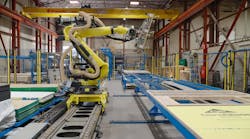One of the first tasks international laboratory planners typically wrestle with is the preparation of a “technical-criteria” or basis-of-design document, one that defines the architectural and engineering requirements of a project. Developing such a document early in a project allows the design effort to flow more smoothly, making the finished design both cost-effective and truly reflective of the client’s needs. Having applied this approach to projects both here and abroad, I can attest to its universal acceptance.
One of the engineering elements addressed in a technical-criteria document is the need for a state-of-the-art HVAC-control package, one capable of supporting the sophisticated pressurization needs of a typical laboratory project. Because it is the laboratory planner’s responsibility to establish this criterion, it is important to learn as much as possible about the issues related to design and execution both here and overseas.
Apparently, there is a basic disconnect between what is done routinely here and what is done throughout the rest of the world. Perhaps that in part explains why domestic laboratory-ventilation systems are notorious for commissioning problems, poor performance, and high maintenance costs, while foreign ones are not. In this column, I will identify the difference in design approach and offer my opinions on how we might improve the delivered product in this country.
The American Approach
Today, with few exceptions, the typical domestic laboratory that houses chemicals is designed with a 100-percent fresh-air (non-recirculating) HVAC system, one capable of creating and maintaining separation (containment with negative pressure or a barrier with positive pressure) between critical spaces. By definition, this means the facility must be equipped with a very sophisticated HVAC pressure-control package, one that transcends the key focus of most mechanical engineers: whether a variable-air- or constant-volume system should be adopted.
While acknowledging the importance of employing in-house control engineers, most engineering firms that routinely work on laboratory projects rely on either outside consultants or direct vendor support. When the vendor route is chosen, the design-level information provided usually is minimal and proprietary, with specific design information limited to outline specifications, a “sequence of operation,” and a “black-box” design solution devoid of any significant detail. This can compromise the consulting engineer’s primary professional responsibility of producing documents that are both biddable and buildable. During the submittal phase, the reviewer often is ill-prepared to evaluate conformance. If problems arise during the installation and commissioning phase, the client and engineer are forced to rely on the vendor for a solution. In light of the limited information provided by the vendor throughout the design and construction process, it should come as no surprise that facilities managers often are forced to enter into long-term maintenance and service-support agreements with the control vendor to keep their systems up and running. This goes against the “interoperability” trend that is so strong with building-management systems today.
Another characteristic of laboratory controls in America today is the reliance on pneumatic actuation. In Europe and Asia, electronic actuators are used.
The International Approach
Overseas, a completely different approach to designing engineering Systems--more specifically, the controls package--generally is utilized. In essence, engineering systems for laboratory buildings are designed as if they were for a chemical process plant. In other words, a “process” approach incorporating piping-and-instrument-drawing (P&ID) documentation, in which every system component is identified, defined, located, and specified early in the design process, is taken. As the design process moves forward, additional layers of information are added, but the basic design remains intact.
The Instrumentation, Systems, and Automation Society (ISA) is an international organization that developed a standard format and symbology for the preparation of P&IDs. It refers to a P&ID as a “map of a process that provides an overall view of the process and the instrumentation in a standard format. Instrumentation diagrams identify each of the instruments in a process, their functions, and their relationship to the other components in the system.”
The ISA says that: “In every process, there are steps or functions that must be measured and controlled in order to produce a quality product. Instrumentation is used to monitor and control each process function. In order to develop a thorough understanding of how a process functions, it is essential to know which devices are included in the process system, how these devices are arranged, and where they are located.”
Adopting Process-Oriented Engineering
Many in the engineering community feel that a process approach to laboratory-building-system design amounts to overkill and is unnecessary. Is it any coincidence that the ones who object the loudest just happen to be the ones who do not have process-engineering technology in their repertoire? Clients may reject the idea of a process-oriented approach, saying that the additional cost is not warranted because they have “full” confidence in their engineer’s ability to do the job. In the same breath, however, they often are quick to point out that they have made sure that sufficient errors-and-omissions coverage is in place—“just in case.”
Conclusion
As laboratory projects continue to grow in size and complexity, it is both logical and cost-effective to utilize any available tool to assure a successful project, one that is completed on time and within budget. That said, applying the process-engineering approach to the design and commissioning of an HVAC-control package makes good sense. I urge you to discuss this approach with engineering firms you might be interviewing for future projects. Many of the larger national firms have embraced the approach by either creating their own in-house capability or developing strategic alliances with process-engineering firms.
To learn more about this design approach--specifically for HVAC-control packages--contact ISA directly at: Instrumentation, Systems, and Automation Society, 67 Alexander Drive, Research Triangle Park, NC 27709.
A member of HPAC Engineering’s Editorial Advisory Board, Jerry Koenigsberg recently retired as principal of GPR Planners, capping a 37-year career spent planning laboratory facilities around the world. He is the author of more than 50 technical articles and papers on laboratory safety and equipment design. Contact him at [email protected].








